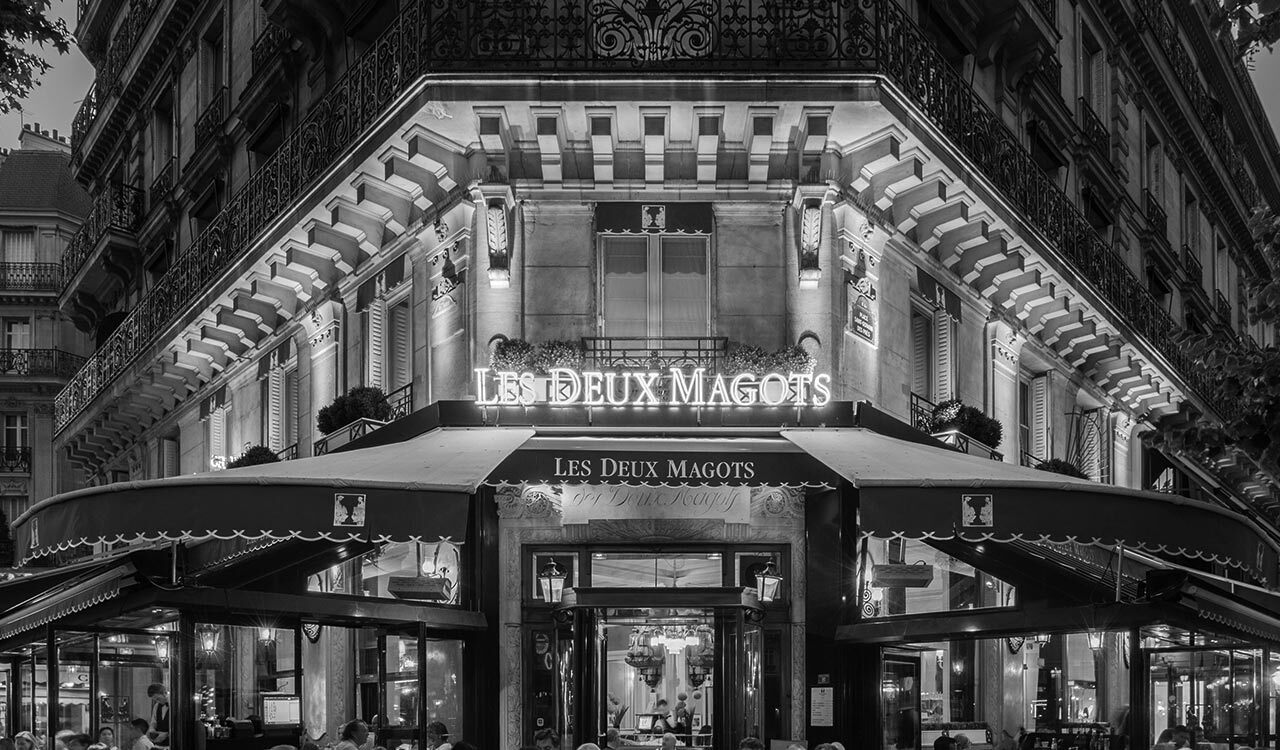Perhaps if you started business in 1885 and have a formidable literary and artist legacy going back nearly two centuries with the same family running the show — and have created an institution over all those years in an achingly desirable and historic corner in Paris — then taking things slowly comes naturally.
But now the restaurant and grande dame café, Les Deux Magots, has worldwide ambitions and has begun to spread its international wings. The plan is to grow slowly and support its Parisian chic flagship while rolling out a new café concept and retail store to make it a global brand. This new chapter of Les Deux Magots is the vision of the owner, great-granddaughter Catherine Mathivat, and her cousin, Brand General Manager Jacques Vergnaud.
“Vergnaud’s plan knows few boundaries. Premium fast-food retail is in his sightline. He is developing a new concept store for takeaway food in mall locations, small-format outlets and in airports. This new concept has its first pilot due to open in Paris on April 15, ahead of the Paris Olympic Games.”
Master Planning
Vergnaud joined the company in 2016 after a career in management consultancy and since his arrival, he has focused the family business on first re-establishing the Parisian institution’s roots and second on a careful international expansion, which kicked off in earnest this year. And there’s a lot more to come.
Les Deux Magots actually started all the way back in 1812 as a silk shop. The two Chinese porcelain figurines from which it takes its name appeared in 1884, by which time it had relocated to Saint-Germain-des-Prés and subsequently converted to a café and liqueur bar under the same name.
Purchased in 1914 by Auguste Boulay, the current owner’s great-grandfather, it became a renowned literary and artist hang-out (Ernest Hemingway, Albert Camus, Pablo Picasso, James Joyce, Bertolt Brecht, Julia Child, James Baldwin, Chester Himes, and Richard Wright) synonymous with the city’s rich cultural history and its Latin Quarter home.
From Paris to Global Expansion
After most of its life as a single location, its real estate (Paris and Tokyo) has doubled this year with openings in Riyadh, Saudi Arabia and Sao Paulo, Brazil, with plans for the international portfolio to reach as many as 15 restaurants by 2030, including two U.S. cities.
“My first goal was to reposition the café and restaurant and also strengthen the brand for Parisians,” says Vergnaud. “This location belongs to its origins; it\’s very historical. So, it\’s very important that the brand be balanced between tourists and Parisians. And we think it has been a success because we grew from €8.2 million ($8.7 million) a year to more than €15 million ($16 million).”
The next step in the café’s manifest destiny is to develop the brand as a selective international chain, always with an eye on maintaining its exclusivity. The plan is to create a café brand and presence that can be replicated globally, limited for most markets to just one per country.
International Intentions
Through something of a quirk, Les Deux Magots already has an international restaurant, though this was for opportunistic rather than strategic reasons. In 1989 the brand established itself in Japan through an interested partner, but as Vergnaud recalls: “It was only through an opportunity because Catherine’s father, the then-owner, was not a development man.”
However, the current generation of Les Deux Magots owners is development-driven and setting sail for all corners of the world. In 2022 the company decided to seek partners for two regions where customers knew the brand well: Saudi Arabia and Brazil. While the brand recognition factor is also high in the U.S., Vergnaud stresses that the company is moving cautiously.
“We want to go to the States. We think that it is of course a relevant market for us, notably New York and Los Angeles. But the point is, America is a mature market and a very expensive market,” he says.
Despite his relaxed demeanour, Vergnaud’s strategy is pretty audacious. Consider making the Oyster Bar in New York City an international phenomenon. It’s a trick managed by some luxury hotels, but a 150-year-old café known and loved for its history in a specific location in the 6th arrondissement in Paris? Replicating that in Saudi Arabia is a stretch. But crazier things have happened.
An Eye on New York and Los Angeles
“Brazil, France, Saudi and Japan are so different. When we are very sure that it is a success, we will go of course to America and we will also pursue our development in 12 to 15 big cities or capitals in China, South Korea, Hong Kong, Singapore, Mexico, New York, LA, and Montreal by 2030,” he explains.
That’s in seven years; and while Vergnaud insists that plan is slow and steady, this is undoubtedly an ambitious global expansion goal.
“It\’s realistic. We want to go step by step because we have a long-term vision. We want to be very exclusive to keep the exclusivity of the brand and not move too quickly because it\’s important to stay in the country for a long time. For example, we are in Japan now for nearly 35 years.”
The current phase of expansion began May 12 in Riyadh and Sao Paulo opened October 18 in the Jardim America district with a restaurant and café occupying nearly 50,000 square feet. “We have a two-hour waiting list during the weekend. Wow, it\’s absolutely incredible. So, it\’s very, very nice for us, and we hope that it will always be a success,” he adds.
The businesses are being developed via licenses and Vergnaud admits that the company needs what he describes as a strong investor. “We need a strong operator, but we need, of course, a beautiful location. It\’s what we are looking for in the different territories. And what is important to understand in our development strategy is quite specific because we want to develop only one flagship per country. So, we need to find the right investor because they normally want to duplicate en masse,” he says.
Building Scarcity
Staying limited is a well-worn strategy for the restaurant because it has had so many opportunities to develop more outlets in France, especially in the affluent south along the Mediterranean coast. But the company has stuck to its guns that it wants only one flagship per country. In fairness, that rule may be bent slightly as Vergnaud has plans to consider Monaco, which is a natural fit as Vergnaud points to many of its customers visiting from the French Riviera,
Vergnaud’s plan knows few boundaries. Fast-food retail is in his sightline. He is developing a new concept store for takeaway food in mall locations, small-format outlets, and airports. This new concept has its first pilot due to open in Paris on April 15, ahead of the Paris Olympic Games.
“Afterwards, we want to sell that concept to our licensees, and Brazil has optioned the counter model, so we are sure that we are going to develop this type of business there and of course, also in Paris. You can have one flagship but many more counters in a country, up to 15 in the largest markets,” he says. “The counter is for takeaway activity, but very premium.” Retail gifts and branded merchandise is also in the plan. He adds, “We want to develop the gifting and merchandising of Les Deux Magots. To validate the idea, we did a lot of surveys, and we are very, very confident of that concept.”
No Copy and Paste Approach
He also stresses that the flagship concept is not a “copy and paste” exercise; instead, each location will take the core principles of the Parisian original and be adapted to the locale. “It\’s very important to understand that each should not literally replicate because it\’s not possible to have exactly the same atmosphere in Tokyo or Brazil. We would have made a mistake if we had done that,” he says. “So, we decided to have six to 10 entrees on the menu exactly the same, but we want to adjust to the local needs. Of course, the Japanese, Saudi or Brazilian diner doesn\’t like the same cuisine.”
“It\’s a very, very big adventure for us. It\’s a new chapter in our history. Because in one year over 50 percent of our revenue will be abroad,” he reflects. “We do about €5 million per flagship, and what is important is not to go too fast, because we have to manage the different culture where we go.”
Honestly, this is the first time we have encountered a global expansion plan built on a Belle Epoque Parisian café. The risk is that such voracious ambitions will make Les Deux Magots ubiquitous, thereby losing its exclusivity and historic sentimental value. Les Deux Magots aprons, dish towels, cookbooks morphing to T-shirts, baseball caps and hoodies? We can’t wait to see how this story turns out!




